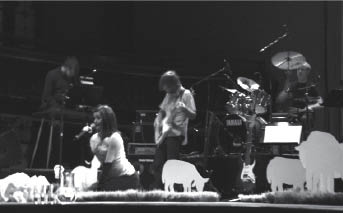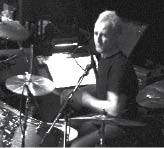Informalities
by Tom Dooney

Bobby Previte, an artist Buffalo can boast as one of its own, returned last week to debut a new collaborative work, titled The Separation, under the Hallwalls aegis. A brief stay, but one that prompts targeting Previte as an artist most wished to resettle in this region—or to at least visit more often—to invigorate cultural life here.
Previte is progeny of the generation of musical innovators at SUNY Buffalo, including Morton Feldman and Jan Williams. Still in his teens, he played in bands that provided rock and jazz scores for the earliest production of Shakespeare in Delaware Park. He is a next-generation innovator himself, living and working in New York City for the past two decades, concocting distinctive blends of serious music, popular culture and interdisciplinary ventures.
Previte, along with his Separationist cohorts, launches familiar genres (church music, rock and jazz) aimed at organized religion, showing its institutions as anything but spiritual. While The Separation has a fundamental weakness, it is a work which warrants ongoing performance and continued revisiting by its creators as well as interested audiences.

It would be a shame if The Separation were only to survive as an audio recording, relegated to some dusty bin. The Separation is a work that begs to be performed live so that an audience can experience virtuosic performances. In addition, live performance would further enhance The Separation’s thematic content.
The work combines ancient, modern and electronic music as well as literary text spoken by an actor.
The 10-voice Rose Ensemble performs, a capella, the 600-year-old score of Guillaume Dufay’s “Missa Sancti Jacobi,” interspersed and overlapped by Marco Benevento’s organ performance of Olivier Messiaen’s “La Nativité du Seigneur” (1935). Previte on percussion with electric guitar ensemble the Coalition of the Willing provides an additional sonic, and epochal, overlay.

There is something like genius afoot here, certainly a high level of mastery of craft. The rock and the ancient and the modern play beautifully against each other, even when simultaneously performed. Credit goes to both Previte’s inspiration as well as to the notable use of sound technology and ambient acoustics in Asbury Hall. In addition, the religious nature of Dufay’s mass and Messiaen’s opus have contextual resonance performed in this converted church.
Just as Previte has provided an amalgam score, playwright Andrea Kleine’s text is a quilt of many colors. To her credit, Kleine’s script scans evenly, as a modern poem by a single author rather than the anthology of parts that it is. Kleine includes Thomas Jefferson’s and Thomas Paine’s discourse on freedom, excerpts on human behavior by Carl Jung and snippets from laboratory reports of the genetic experiments that brought Dolly the sheep to cloned life. The subject “lamb” is alternately the divine or the dupe, the playful individual or the member of some faceless flock. Christine Holt’s reading of the text is charming, bright and articulate.
The Separation shies away from its theatrical intentions, which is a shame. At present, it exists like a reading overwhelmed by its background music (superb though the music is). The Separation has the potential to be an oratorio for our times, a heartfelt warning of bad things yet to come. Wisdom from those who survived the Holocaust, like Messiaen, or who recall the Jonestown Massacre.

Undertheatricalized as it exists now, The Separation encourages passivity, treating audiences as sheep in the very ways religion and society do. Its text demonstrates information for us rather than encouraging thought. The scenic visuals, which narrow our attention to the finite, never suggesting a world beyond. Its score, which expertly contains us, is never used to inspire us to respond and to move as individuals.
The Separation has too closely modeled itself on the structure of a mass rather than fully realizing itself as an original work of art. Imitation of ritual is a superficial and does not serve the scope of The Separation.
Why bicker over form? First, it is discourse inherent to new work. Second, specific to The Separation, which avoids formal commitments, one must first have form in order for transformation to occur. An audience witnessing transformation, and experiencing it empathically, is the soul of theater. All the rest of it is church.
|
Issue Navigation> Issue Index > v6n7: It's Mardi Gras Time! (2/15/07) > Informalities This Week's Issue • Artvoice Daily • Artvoice TV • Events Calendar • Classifieds |









 Current Issue
Current Issue